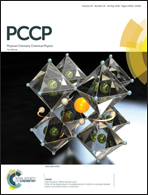Structural and photodynamic properties of the anti-cancer drug irinotecan in aqueous solutions of different pHs†
Abstract
This work reports on photophysical studies of the irinotecan (IRT) anti-cancer drug in water solutions of different acidities (pH = 1.11–9.46). We found that IRT co-exists as mono-cationic (C1), di-cationic (C2), or neutral (N) forms. The population of each prototropic species depends on the pH of the solution. At pH = 1.11–3.01, the C1 and C2 structures are stabilized. At pH = 7.00, the most populated species is C1, while at pH values larger than 9.46 the N form is the most stable species. In the 1.11–2.61 pH range, the C1* emission is efficiently quenched by protons to give rise to the emission from C2*. The dynamic quenching constant, KD, is ∼32 M−1. While the diffusion governs the rate of excited-state proton-transfer (ESPT) under these conditions, the reaction rate increases with the proton concentration. A two-step diffusive Debye–Smoluchowski model was applied at pH = 1.11–2.61 to describe the protonation of C1*. The ESPT time constants derived for C1* are 382 and 1720 ps at pH = 1.11 and 1.95, respectively. We found that one proton species is involved in the protonation of C1* to give C2*, in the analyzed acidic pH range. Under alkaline conditions (pH = 9.46), the N form is the most stable structure of IRT. These results indicate the influence of the pH of the medium on the structural and dynamical properties of IRT in water solution. They may help to provide a better understanding on the relationship between the structure and biological activity of IRT.



 Please wait while we load your content...
Please wait while we load your content...